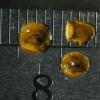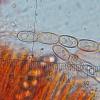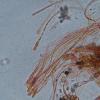
17-09-2025 10:50
Heather MerryleesHi there!I am hoping for any advice on the identif

27-11-2025 11:46
Thomas Læssøehttps://svampe.databasen.org/observations/10493918

29-11-2025 08:40
 Andreas Millinger
Andreas Millinger
Hello,on a splintered part of a branch on the grou

28-11-2025 16:45
Nogueira HéctorNovember 23, 2025 Requejo de Sanabria (León) SPAI

25-11-2025 14:24
Thomas Læssøehttps://svampe.databasen.org/observations/10490522

27-11-2025 15:41
Thomas LæssøeSpores brownish, typically 4-celled; 26.8 x 2.4;

27-11-2025 12:01
Thomas Læssøehttps://svampe.databasen.org/observations/10496727

27-11-2025 11:31
Thomas LæssøeCollectors notes: Immersed ascomata, erumpent thro

23-09-2025 13:31
Thomas Læssøehttps://svampe.databasen.org/observations/10534623

26-11-2025 18:13
The entire run of Mycotaxon is now available throu
Anthracobia sp.
Vasileios Kaounas,
22-01-2014 18:48
Asci dimensions 190-215 x 11-14,5 ?m. Ascospores dimensions 12,5-18,5 x 9,5-10,5 ?m. Width paraphyses 7,5-9,5 ?m.
Enrique Rubio,
22-01-2014 18:55
Re : Cheilymenia ???
It's an Anthracobia species, typical of burnt ground
DirkW,
22-01-2014 19:08

Re : Cheilymenia ???
salut vasileios, as enrique said, its anthracobia: a. macrcoystis, a. nitita or a. melanoma. most important are the hairs, which are missing. can you show the hairs too?
best
dirk
best
dirk
Vasileios Kaounas,
22-01-2014 19:17
Re : Cheilymenia ???
Thank you, will look again, because I did not see hairs.
DirkW,
22-01-2014 19:22

Re : Cheilymenia ???
the hairs are very unconspicious! perhaps under 80 and very pale.
Vasileios Kaounas,
23-01-2014 10:33
Re : Anthracobia sp.
I tried, but I did not see hairs.....
Vasileios Kaounas,
28-02-2014 15:56
Re : Anthracobia sp.
I found it again in the same place, i put Melzer and the asci were not amyloidi, but maybe made the paraphyses ? Hair again I dont saw.
Enrique Rubio,
28-02-2014 16:57
Re : Anthracobia sp.
The inconspicuous roundish hairs belong to Anthracobia macrocystis or A. nitida, but I don't know well the differences between these two species. The greenish reaction of the paraphyses in iodine are typical for their content in carotenoid pigments.
Vasileios Kaounas,
28-02-2014 17:21
Re : Anthracobia sp.
Thanks Enrique.
macrocystis = Asci cylindrical, 165-190 x 11-15 ?m, 8-spored, operculate, not bluing in iodine. Asco-spores uniseriate, smooth, biguttulate, elliptical to narrowly ellipti¬cal, (16)17-20 x 7.5-9.0 ?m,
nitida = Asci cylindrical, 170-210 x 9-12 ?m, 8-spored, operculate, not bluing in iodine. Ascospores uniseriate, uninucleate, smooth, biguttulate, elliptical, 16-19 x (6)7-9 ?m
http://ir.library.oregonstate.edu/xmlui/bitstream/handle/1957/44151/LarsenHarold1976.pdf?sequence=3
not helped these differences !!!
macrocystis = Asci cylindrical, 165-190 x 11-15 ?m, 8-spored, operculate, not bluing in iodine. Asco-spores uniseriate, smooth, biguttulate, elliptical to narrowly ellipti¬cal, (16)17-20 x 7.5-9.0 ?m,
nitida = Asci cylindrical, 170-210 x 9-12 ?m, 8-spored, operculate, not bluing in iodine. Ascospores uniseriate, uninucleate, smooth, biguttulate, elliptical, 16-19 x (6)7-9 ?m
http://ir.library.oregonstate.edu/xmlui/bitstream/handle/1957/44151/LarsenHarold1976.pdf?sequence=3
not helped these differences !!!
Stephen Martin Mifsud,
17-01-2017 06:49

Re : Anthracobia sp.
I found three populations of Anthracobia nitida but one of the populations had smaller spores then reported: 14-16um long, more or less the same as reported by Vasileios Kaounas ( the poster of this post) from Greece. I guess it still qualifies as A. nitida.
In the work of Larsen Harold (1976) this population would classify as Anthrocobia taxonomic species A if you follow the keys on page 42-44/92 (and gosh - that thesie was produced with a type-writer!)
Myself, I have problems to distinguish (from literature) nitida and macrocystis (just tiny differences in hair length and spores, which intersect anyway), but I think I have spotted a third difference (from Larsen Harold descriptions of both spp.) where A. nitida has a more pronounced brown-spotted clothing on the lower surface of the excipulum from that of A. macrocystis (where from the description they are lighter or restricted to the margin). See my image below
What do you think please?
In the work of Larsen Harold (1976) this population would classify as Anthrocobia taxonomic species A if you follow the keys on page 42-44/92 (and gosh - that thesie was produced with a type-writer!)
Myself, I have problems to distinguish (from literature) nitida and macrocystis (just tiny differences in hair length and spores, which intersect anyway), but I think I have spotted a third difference (from Larsen Harold descriptions of both spp.) where A. nitida has a more pronounced brown-spotted clothing on the lower surface of the excipulum from that of A. macrocystis (where from the description they are lighter or restricted to the margin). See my image below
What do you think please?
 chelymenia-0001.pdf
chelymenia-0001.pdf

